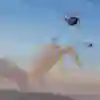
Skydiving
With the planning, testing and engineering help of Dr Paulo Iscold, Luke Aikins and Andy Farrington will perform the first-ever dual jump between two planes in an epic live event on April 24.
The idea sounded impossible. Two solo-piloted planes diving toward the ground, with each pilot jumping from their plane and then diving alongside and into the other plane. When the concept was presented to Paulo Iscold – an engineer, college professor and pilot himself – he questioned the sanity of the person presenting the idea to him: skydiving legend Luke Aikins.
Iscold had first met Aikins after the skydiving master had jumped from 25,000ft (7,620m) without a parachute and landed into a giant net in 2016. The professor of aerospace engineering questioned Aikins's sanity, but after plenty of discussion, Iscold could appreciate the science behind the daredevil act.
See history being made: watch Plane Swap live right here
The two remained more than casual acquaintances when pilot Kevin Coleman encouraged Iscold to talk with Aikins about the concept of two skydivers jumping from one plane into the others' aircraft.
Again, Iscold could hardly believe what he was hearing. "He had the idea to swap aeroplanes in the air, it's kind of crazy again," Iscold recalled. "But nobody did that before and I always liked the idea of getting involved in stuff that nobody's done before. I told him right away, 'I'm in, I want to do it. Whatever it takes, I'll do it'."
What started out as a crazy thought becomes reality on April 24. During the Plane Swap live broadcast, Aikins and his cousin Andy Farrington will jump out of planes barreling toward the ground, manoeuvre into each others' planes and take control of the planes and fly away. Sounds perfectly sane, right?
This is an event that's hardly been conceptualised, much less attempted. Never in the history of flight has a pilot taken off in one plane and landed in another. Yet this milestone features not just one, but two pilots who are going to simultaneously perform a feat that may last all of 40 seconds but will be an engineering marvel that will have taken the better part of a year to execute. It became apparent that to execute such an incredible feat, the pilots would have to not only have steely nerves but also defy the laws of physics.
"There's a whole bunch of very cool engineering going on, some fancy designs," Aikins said. "The big thing is we have to prove that these planes, basically they change. It's almost like a transformer. When we put this giant brake down and turn the engine off, it's impossible for the plane to fly anymore. It's now a falling object. This plane is no longer aerodynamically capable of flying. It's just kind of falling through the air until you get back in it, switch everything over and turn it back into an aeroplane again, so that it can fly. You couldn't land it with this brake down.
"When this happens, it’s going to be one of those cool moments for me that we jumped through every hurdle, and here we are, ready to make it happen."
One person playing a big part in making Plane Swap happen is Iscold, who's designed aeroplanes that have set multiple world records over the past two decades. Yet this project is like nothing else he's worked on before.
Instead of flying faster, the goal is to slow down the planes as they're barreling toward the Earth – and while they're doing it, they have to remain steady enough on the descent that Aikins and Farrington can enter the planes and take control of the aircraft and fly away. That’s where the laws of physics are being tested.
"The most natural idea was to use a drogue shoot, a parachute attached to the aeroplane," Iscold said. "I asked, why don't you just do that? He said, 'Well, the problem is, first, it doesn't look good because you always have these people who don't understand why the aeroplane is not going so fast while diving'. But it's also difficult to develop, because every time that you do a dive, you need to deploy the parachute and then you need to retrieve the parachute. So there's no way for us to test it and what's important in this process is to understand that, yes, what they're doing is unique. We're only going to do that one time, but we are approaching that problem step-by-step.”
Iscold broke down that step-by-step with a humorous analogy of how to eat an elephant; piece-by-piece. The team broke down the flight into the ascent to between 12,000ft and 14,000ft (approximately 3,650m and 4,270m), the levelling off, nosedive that includes the pilots jumping and swapping planes and then taking control of the planes and flying off. Yet, as a true engineer, Iscold quickly found that there were a couple of major problems that needed to be resolved.
The aircraft needed to fly in formation straight toward the ground and remain steady enough for the skydivers to manoeuvre through the air and into a door about the width of a household refrigerator, but not quite as tall. Also, the planes need to slow down on the way down, because untethered the aircraft would travel at too high a speed for the jumpers to catch up – and the planes would soon disintegrate because of the velocity.
So, having the planes freefall was quickly ruled out, as was the aforementioned drogue chute. Iscold and the team came upon two solutions that would need to be developed exclusively for Plane Swap. First, they would have to create a speed brake that would slow down the plan on the dive and help keep it steady. Second, the development of an autopilot that would be able to control the planes as Aikins and Farrington exited and re-entered each others' planes.
"I knew that what we needed to do for the project was to develop the speed brake system and to develop the autopilot system," Iscold said. "That's another part that's unique on the project. Normally the autopilot is designed to fly the aeroplane straight level and you can't buy an autopilot that flies the aeroplane straight down, so we knew since day one that those were the parts that we had to develop.
"It's very interesting that the same way that we thought that the speed brake would be way smaller and way simpler, we thought the autopilot would be able to track a point on the ground. You know, you just point the aeroplane to that point and make sure you fly towards that point. Very quickly through the development, though, we realised that you can't do that because you have wind. So, the skydiver would be floating with the wind and you also need to allow the aeroplane to move with the wind, so they own the same mass of air. Those are the things that, you start a project, think that you're going to do it one way, but through the project, you change your mind."
The speed brake was complicated, because not only did it need to be able to slow down and steady the plane, but it also needed to be functional enough to be able to become a part of the Cessna 182 aeroplanes. One of the team members, Ryan Malherbe, suggested a very clever way to affix the speed brake to the bellies of the planes. As the planes went into a dive, the speed brakes would be opened up and go perpendicular to the belly of the aircraft.
At first, the speed brake's deployment was tested at an airport in San Luis Obispo, California, near the college where Iscold teaches Aerospace Engineering. The planes would be lifted by a crane to test the lowering of the "barn door", as Aikins compared it to. That had several trial runs before they could test it in the air.
Once the team tested in the air, there were multiple modifications, because early versions weren't able to tip the planes more than about a 70-degree angle toward the ground. A successful Plane Swap required a 90-degree dive. That's when airflow became a necessary consideration. 'Down Wash' became a term that grew quite familiar. How the air flowed not only around the wings but also through the tails of the planes had to be calculated. A crack of air between the belly of the plane and the speed brake had to be created so that air could flow both above and below the brake, and through the tail.
"This wing isn't symmetrical, so it has a little bit of curvature, which means that at zero angle of attack it's producing a little bit of lift," Iscold said. "So, you need to place it a little bit over 90-degree to produce zero lift. And why do we want zero lift? We want zero lift because when the aeroplane is going down if you have a force, this force makes the plane accelerate. We can't afford that because the skydiver is heading vertically to the ground. So that's why we need, let's say 90-degree towards the ground, but the aeroplane will be at a 95-degree angle. So the aeroplane is at a little angle, but it's going 90-degree towards the ground."
Iscold's calculations are that the entire stunt will take less than a minute once the planes go into tandem nosedives. "It's literally all the work that I've been doing for a year is for 40 seconds of dive flight," Iscold quipped. "It's 365 days of work for 40 seconds of outcome."
It fell upon the autopilot to maintain those nosedives, which needed to be customised for this event. For this stunt to be a success, the planes have to continue to fly in controlled formation toward the ground and work in tandem with the speed brake. Iscold and Leo Torres, a fellow professor at Cal Poly San Luis Obispo, worked on the development of this automated system.
At first, they created a system that was too precise. This would call for continual self-correction of the aircraft, which made it difficult for Aikins and Farrington to enter the planes. So, the autopilot was modified to become "lazy", as Iscold called it. This will hold the planes more steady to make it easier for re-entry.
The re-entry for each of the skydivers is tricky because even though the planes aren't travelling full speed, they're still travelling about 225kph. The G-force has to be considered for how Aikins and Farrington will enter the aircraft and be able to get to the cockpit and hit the button to deactivate the nosedive and automatically correct the plane back to an angle to take control and fly away.
"That was one of my concerns, the fact that the aeroplane is vertical and you can't sit in your seat anymore," Iscold said. "I came up with all sorts of solutions to allow them to move inside the aeroplane while diving, but when we did the first skydive with the aeroplane, Andy grabbed the strut, crawled towards the aeroplane and placed his chest on the door frame, one leg and arm inside the plane, the other outside the aeroplane. At that position, he could easily start the dive recovery process and then sit back on the seat. So, this is just an example that, as an engineer, it's super easy for me to create solutions for problems that actually don't exist. That's the reason that all the test flights during the development of the project are important."
At that point, the speed brake becomes a detriment. As the plane steadies, velocity is necessary to fly away and complete the successful event. "After starting the recovery sequence, the plane speed starts to decrease, and we need to re-start the engine and immediately retract the speed brake," Iscold said. "This will allow the plane to fly again, come back to land and finish the sequence."
The Plane Swap team have been testing these past several months at San Luis Obispo Airport, with support from Edward 'Tres' Clements and Kyle Inks from the company Aerocrafted. Iscold said the men and their company have given continual support in the development of all the customised parts for this unique project. Aaron Fitzgerald is another pilot who's been a part of the testing and practice runs for Plane Swap.
"All these achievements are only possible when you work with a team, and it's important for everyone around the world to select the best team that they can work with," Iscold said. "This past year was an opportunity for me to observe how Luke works, how Andy works, how the team works and make my decision. Do we want to keep being part of this or not? And the decision so far is I'm going to go all the way to the end with those guys."
The culmination for Plane Swap is over the Arizona desert on April 24. Even though it won't be searing temperatures that are the norm during the summer, the weather will be warmer than the climate in which they've been performing test flights in San Luis Obispo. That has been calculated as well.
"There's a little bit of difference with the hotter temperature," Iscold said. "The velocity that we fall at is a little bit higher because the air is less dense. We cannot afford to be too hot, so that's the reason that we're aiming for late afternoon, because we should have more reasonable temperatures. High temperatures on the ground also produce more turbulence, but the conditions that we fly in here in San Luis Obispo, with the offshore wind, are also very turbulent. I don't think turbulence will be a big deal for us in Arizona. I think what we're doing here is very similar to what we're doing there. Hopefully, San Luis Obispo will give us some good weather for the next test flights, and Arizona will not give us a crazy hot day.”
With interest building around Plane Swap, the questions the team has received are typically in regards to how far the laws of physics can be tested.
"One question that's coming up a lot recently from my students and other people here at the airport is why we're doing this and if this will become a product or if there's a speed brake that can be used on another aeroplane," Iscold said. "What I'm saying to people is it's not every project that we do that we need to save the world. It's OK to do projects that are just for fun, and happiness is not the destination, it's the journey. I'm enjoying the journey to get there.
"From the technological perspective, it's just a different challenge. It will not become a product. It will not make anything better in the world, but it will make me sharper and better to solve other problems later on. What we're trying to do here is to inspire people and to show people that no matter how big the problem ahead of you is, if you treat the problem well and if you eat the elephant piece-by-piece, you can always eat the whole elephant."
Now that they've worked together and are nearing the finish line on another aviation feat that blazes a trail for others to follow, Iscold has very much changed his tune as to his first impression upon meeting Aikins.
"The difference between being crazy and being a genius, it's teeny-tiny, is that right?" Iscold said. "The most genius people in the world, you look at them, and you think they’re crazy. Luke, for sure, is on the genius side. You talk with him, and you might think that his ideas are crazy, but in the back of his mind, he has a plan, and those plans are pretty well put together. So, no, he's not crazy at all."
See history being made: watch Plane Swap live right here





















